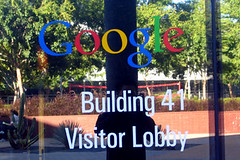Google Vs Yahoo - Who's Greener? by Chris Erichsen
Silicon Valley is known for both innovation and hype. Recently, this pool of innovation has extended beyond bandwidth to the protection of the environment. Google and Yahoo, the search engine giants, are both headquartered in the Valley and have been making headlines by greening their offices, reducing energy consumption, and carbon trading. The PR motivations are obvious, but are the green benefits really there? To set apart the hype from reality, we have analyzed the green value of both Google and Yahoo's headquarter facilities.
We looked at the ecological services provided by green landscape features such as trees and open space (i.e. grass). Grass and trees are pervious surfaces, meaning they allow water to permeate into the ground. Roofs, sidewalks, patios, and asphalt parking lots are examples of impervious surfaces, where rainwater drains into the public storm drains. Heavy metals, oil, and other pollutants are carried off parking lots in rainwater, which often lead directly to open water habitats, where fish, birds, and reptiles live.
In terms of ecological services, trees and grass have been proven to:
1. Remove and store carbon from the atmosphere
2. Remove certain airborne pollutants
4. Remove certain waterborne pollutants
Here is a look at how green Google and Yahoo really are and how they measure up against each other.
Google Green Report
Google's headquarters, the Googleplex, covers 44 acres, nearly 50% of which is grass or tree canopy. This is an impressive paved to open space ratio. The grass and trees on the Googleplex remove roughly 2 tons of carbon from the atmosphere per year, or 0.04 tons per year per acre.
In addition, 530 lbs. of air pollution are removed per year (e.g., ozone, carbon monoxide, nitrogen dioxide, sulfur dioxide, and particulate matter), or 12 lbs. per year per acre. It was assumed that the parking lot of the Googleplex is asphalt, and not a type of porous pavement, so the cost of managing rainfall runoff from the Googleplex is $4,474 per year, or $103 per year per acre.
The abundance of grass and tree canopy on the Googleplex goes a long way to offset the water quality impacts of the paved surfaces (mainly the parking lot). On average, the grass and trees reduce water pollution by 6%, as opposed to the entire property being paved.
Yahoo Green Report
The Yahoo headquarters, Yahooplex, covers 28 acres, a third of which is grass or tree canopy. This is a classic ratio of paved to open space for large office complexes in California. So far, par for the course.
The Yahooplex removes 0.36 tons of carbon from the atmosphere per year, or 0.01 tons per year per acre. 114 lbs. of air pollutants are removed per year, or 4 lbs. per year per acre. In terms of rainfall, the cost associated with runoff is $9,219 per year, or $331 per year per acre.
The grass and tree canopy help offset the paved areas with a 2.3% reduction in water pollution as opposed to the entire property being paved.
The final green analysis?
Google kicks Yahoo's butt, largely due to the forethought, or luxury, of the Googleplex having 50% of its property surface providing green services. The good news for both Google and Yahoo is that over time, as trees grow, so will the tree's canopy and mass, thus storing more carbon and removing more air pollutants.
Green next steps for both Google and Yahoo is to:
- Install porous parking surfaces, allowing up to 80% of rainwater to seep into the ground
- Install green roofs, absorbing rainwater while reducing cooling costs and energy consumption
- Planting larger trees on the south and west sides of the buildings to reduce cooling costs and energy consumption
Chris Erichsen is a GIS Mapping consultant with the Erichsen Group, GIS and Mapping in northern California. He has over 10 yrs of GIS experience and helps many industries around the world apply GIS mapping technology. Learn more examples of GIS mapping capabilities.
Article Source: http://EzineArticles.com/?expert=Chris_Erichsen
http://EzineArticles.com/?Google-Vs-Yahoo---Whos-Greener?&id=2186117
http://thezeitgeistischanging.blogspot.com/
http://psychedelichippiemusic.blogspot.com/
http://psychedelichippiefashion.blogspot.com/
http://www.soul-flower.com/Merchant2/merchant.mvc?Screen=SFNT&Store_Code=SOS&AFFIL=Robert_Muller

No comments:
Post a Comment